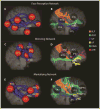White matter pathways and social cognition
- PMID: 29684403
- PMCID: PMC5993647
- DOI: 10.1016/j.neubiorev.2018.04.015
White matter pathways and social cognition
Abstract
There is a growing consensus that social cognition and behavior emerge from interactions across distributed regions of the "social brain". Researchers have traditionally focused their attention on functional response properties of these gray matter networks and neglected the vital role of white matter connections in establishing such networks and their functions. In this article, we conduct a comprehensive review of prior research on structural connectivity in social neuroscience and highlight the importance of this literature in clarifying brain mechanisms of social cognition. We pay particular attention to three key social processes: face processing, embodied cognition, and theory of mind, and their respective underlying neural networks. To fully identify and characterize the anatomical architecture of these networks, we further implement probabilistic tractography on a large sample of diffusion-weighted imaging data. The combination of an in-depth literature review and the empirical investigation gives us an unprecedented, well-defined landscape of white matter pathways underlying major social brain networks. Finally, we discuss current problems in the field, outline suggestions for best practice in diffusion-imaging data collection and analysis, and offer new directions for future research.
Keywords: Diffusion imaging; Face processing; Mentalizing; Mirroring; Social cognition; Tractography; White matter.
Copyright © 2018 Elsevier Ltd. All rights reserved.
Figures





Similar articles
-
The Original Social Network: White Matter and Social Cognition.Trends Cogn Sci. 2018 Jun;22(6):504-516. doi: 10.1016/j.tics.2018.03.005. Epub 2018 Apr 5. Trends Cogn Sci. 2018. PMID: 29628441 Free PMC article. Review.
-
Evidence for Functional Networks within the Human Brain's White Matter.J Neurosci. 2017 Jul 5;37(27):6394-6407. doi: 10.1523/JNEUROSCI.3872-16.2017. Epub 2017 May 25. J Neurosci. 2017. PMID: 28546311 Free PMC article.
-
Impairments of white matter tracts and connectivity alterations in five cognitive networks of patients with multiple sclerosis.Clin Neurol Neurosurg. 2021 Feb;201:106424. doi: 10.1016/j.clineuro.2020.106424. Epub 2020 Dec 8. Clin Neurol Neurosurg. 2021. PMID: 33348120
-
White matter and cognition: making the connection.J Neurophysiol. 2016 Nov 1;116(5):2093-2104. doi: 10.1152/jn.00221.2016. Epub 2016 Aug 10. J Neurophysiol. 2016. PMID: 27512019 Free PMC article. Review.
-
EEG functional connectivity is partially predicted by underlying white matter connectivity.Neuroimage. 2015 Mar;108:23-33. doi: 10.1016/j.neuroimage.2014.12.033. Epub 2014 Dec 19. Neuroimage. 2015. PMID: 25534110 Free PMC article.
Cited by
-
Sex and Age-at-Injury as Determinants of Social Behavior Outcomes After TBI.Adv Neurobiol. 2024;42:205-218. doi: 10.1007/978-3-031-69832-3_10. Adv Neurobiol. 2024. PMID: 39432044 Review.
-
White Matter Correlates of Theory of Mind in Patients With First-Episode Psychosis.Front Psychiatry. 2021 Mar 5;12:617683. doi: 10.3389/fpsyt.2021.617683. eCollection 2021. Front Psychiatry. 2021. PMID: 33746794 Free PMC article.
-
Brain Structure Alterations in Poly-Drug Use: Reduced Cortical Thickness and White Matter Impairments in Regions Associated With Affective, Cognitive, and Motor Functions.Front Psychiatry. 2019 Sep 20;10:667. doi: 10.3389/fpsyt.2019.00667. eCollection 2019. Front Psychiatry. 2019. PMID: 31616326 Free PMC article.
-
The Original Social Network: White Matter and Social Cognition.Trends Cogn Sci. 2018 Jun;22(6):504-516. doi: 10.1016/j.tics.2018.03.005. Epub 2018 Apr 5. Trends Cogn Sci. 2018. PMID: 29628441 Free PMC article. Review.
-
Predicting pragmatic language abilities from brain structural MRI in preschool children with ASD by NBS-Predict.Eur Child Adolesc Psychiatry. 2025 Jun 11. doi: 10.1007/s00787-025-02775-w. Online ahead of print. Eur Child Adolesc Psychiatry. 2025. PMID: 40495017
References
Publication types
MeSH terms
Grants and funding
LinkOut - more resources
Full Text Sources
Other Literature Sources

